Overnight, Refrigerator Focaccia = The Best Focaccia Bread Recipe
This post may contain affiliate links. Please read my disclosure policy.
Cold, refrigerated dough is the secret to making delicious focaccia! Allowing the dough to rest 18 to 48 hours in the fridge will yield extra-pillowy and airy focaccia, though if you are pressed for time, you can make this start-to-finish in 3 hours. This 4-ingredient recipe requires only 5 minutes of hands-on time. Video guidance below!
⭐️⭐️⭐️⭐️⭐️ Review:
“Love this recipe! I’ve made this so many times that I’ve lost count. Super simple and delicious. My family loves it. Whenever someone asks me for a focaccia recipe, I always show them this one. This recipe is awesome. Thank you for sharing!” — Lucy
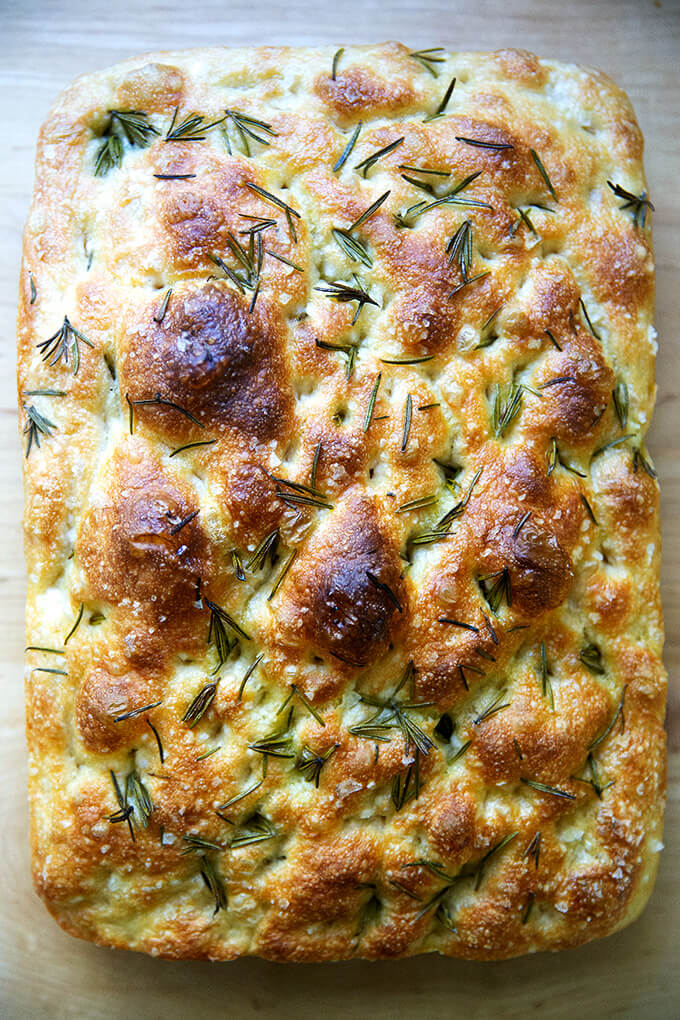
I’ve said it before and I’ll say it again: focaccia is the bread recipe for beginners. Why? Because:
- The no-knead, 4-ingredient dough takes 5 minutes to mix together.
- It requires no special equipment, no tricky shaping technique, and no scoring.
- If you have a 9×13-inch baking pan and your fingertips (for dimpling), you’re good to go.
- It emerges soft and pillowy, olive oil-crusted, golden all around, and it’s completely irresistible.
In sum, it’s hard to beat focaccia (pronounced foh-kah-chuh) in the effort-to-reward category. If you are intimidated by bread baking, this is the recipe I suggest making first, both for its simplicity and flavor. After all, this focaccia bread recipe is adapted from my mother’s simple peasant bread recipe, a recipe that has removed the fear of the bread baking process for many.
For the past few months, I’ve been making the focaccia bread recipe from my cookbook Bread Toast Crumbs, but changing the method: using more yeast, using less yeast, doing longer, slower rises at room temperature, doing longer, slower rises in the refrigerator. Find the results below.
This post is organized as follows:
- What Makes The Best Focaccia
- Four Tips for Success
- How This Focaccia Recipe Differs from Others
- Focaccia Bread Ingredients
- How to Make Focaccia, Step by Step
- Adding Rosemary, Herbs and Other Toppings to your Focaccia Dough
- How to Make a Focaccia Bread Art
- Tomato Focaccia
- How to Make a Focaccia Bread Sandwich
- Can I Skip the Overnight Rise?
PS: Once you master this simple focaccia, try your hand at this simple sourdough bread recipe, another recipe that requires minimal effort but yields spectacular results.

What Makes The Best Focaccia?
I’ll spare you all the details of the various experiments and skip straight to what I’ve found creates the best focaccia, one that emerges golden all around, looking like a brain, its surface woven with a winding labyrinth of deep crevices: high-hydration, refrigerated dough.
This is nothing novel—many bakers extol the virtues of the cold fermentation process—and it came as no surprise to me either: it was, after all, past-prime Jim Lahey refrigerated dough that showed me how easy focaccia could be: place cold, several-days-old pizza dough in a well-oiled pan, let it rise for several hours or until it doubles, drizzle with more oil, dimple with your fingers, sprinkle with sea salt, then bake until done.
Employing a refrigerator rise requires more time because the cold environment slows everything down initially, and during the second rise, the cold dough takes time to warm to room temperature. The overall effort, however, is very hands-off, and the result — a light, airy, pillowy dough — is well worth it.
As important as refrigerating the dough is using a high hydration dough, meaning a dough with a high proportion of water relative to the flour. The high proportion of water will create a dough with beautiful air pockets throughout. (Incidentally, this is the secret to making excellent pizza dough as well as light, airy sourdough sandwich bread.)
How This Focaccia Recipe Differs from Others
There are lots of focaccia bread recipes out there, so why make this one? This one differs from many of the recipes out there in two ways:
- The long, cold, refrigerator rise.
- The absence of sugar or honey or any sort of sweetener.
Why isn’t there any sweetener in this recipe? Simply stated, a sweetener is just not needed — the yeast, contrary to popular belief, does not need sugar to activate or thrive. Sugar will speed things up, but when you’re employing a long, slow rise, speed is not the name of the game.
Moreover, and this is getting a little scientific, but during the long, cold fermentation: enzymes in both the flour and the yeast will break down the starches in the flour into simple sugars, which will contribute both to flavor and to browning, again rendering sugar unnecessary. Cool, right?
Four Tips for Success
- Allowing the dough to rest 18 to 24 hours in the fridge yields the best results. (You can leave the dough in the fridge for as long as 72 hours.)
- A buttered or parchment-lined pan in addition to the olive oil will prevent sticking. When I use Pyrex or other glass pans, butter plus oil is essential to prevent sticking. When I use my 9×13-inch USA Pan, I can get away with using olive oil alone.
- Count on 2 to 4 hours for the second rise. This will depend on the temperature of your kitchen and the time of year.
- After the second rise, dimple the dough, then immediately stick the pans in the oven — this has been a critical difference for me in terms of keeping those desirable crevices. If you dimple and let the dough rise again even for 20 minutes before popping the pan in the oven, the crevices begin to dissolve.
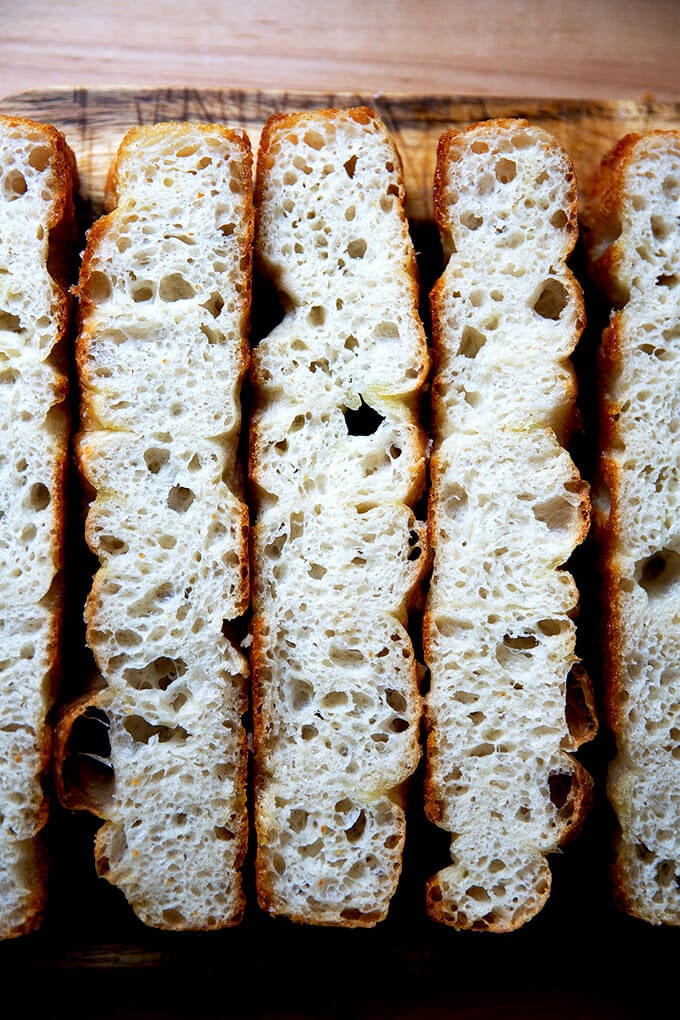
Ingredients
- Flour: bread flour or all-purpose flour will work equally well here. If you live in a humid environment or abroad, I suggest trying to get your hands on bread flour. King Arthur Flour is my preference.
- Yeast: SAF Instant Yeast is my preference, but active dry yeast works just as well. See recipe box for instructions on how to use active-dry yeast in place of instant.
- Salt: I say this all the time, but a big part of making a good loaf of bread comes down simply to using the right amount of salt given the amount of flour you are using by weight. It’s like anything: bread has to be well seasoned. At a minimum, use 10 grams (2 teaspoons) of salt for every 500 grams (4 cups) of flour. I highly recommend investing in some good, flaky sea salt for sprinkling on top of the focaccia dough — it tastes better than the more finely ground varieties of salt. I use Diamond Crystal kosher salt for the dough, but any salt you have on hand will work just fine for the dough.
- Water: There is a lot of water in this dough — it’s 88% hydration — and all of that water helps produce a light, airy, pillowy dough.
- Olive oil: Olive oil both in the bottom of the pan and on top of the dough is essential for encouraging nice browning, flavor, and that quintessential oiliness we all love about focaccia.
- Rosemary or other seasonings: Rosemary is a classic focaccia topping, and you can either sprinkle it over the dough before baking or you can chop it up and add it to the dough. Many people love sun-dried tomatoes and olives in their focaccia. See below for how to incorporate these other ingredients into your focaccia dough.
How to Make Focaccia Bread, Step by Step
Gather your ingredients: 4 cups (512 g) flour, 2 teaspoons (10 g) salt, 2 teaspoons (8 g) instant yeast (SAF is my preference), 2 cups (455 g) water:
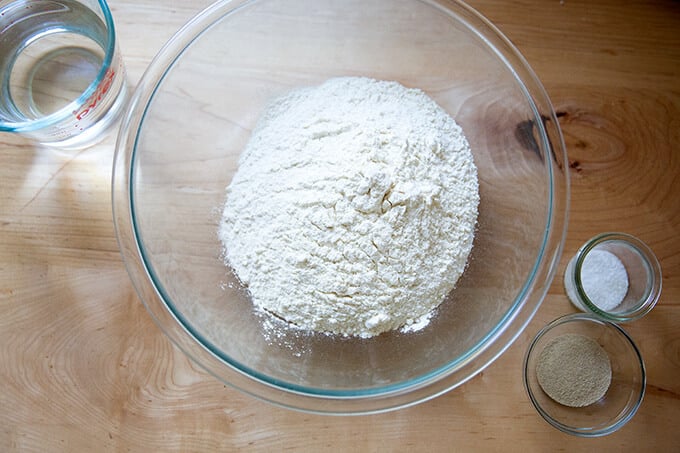
Whisk together the flour, salt, and yeast first:
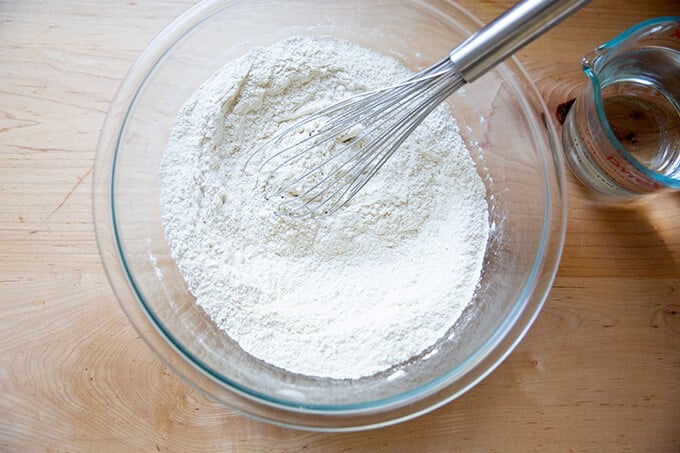
Add the water:
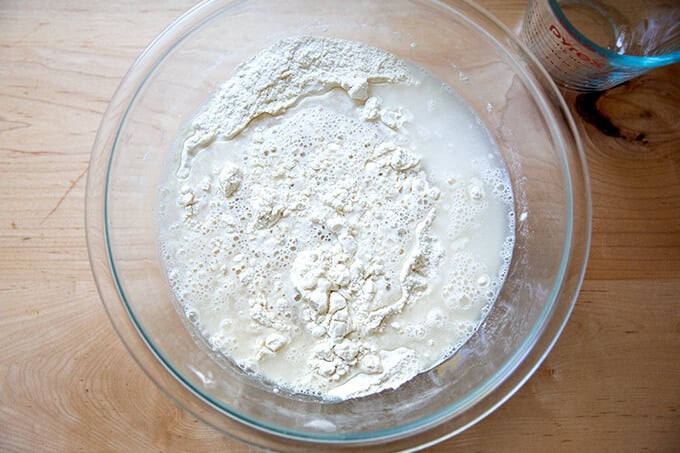
Use a spatula to stir the two together.

Slick the dough with olive oil:
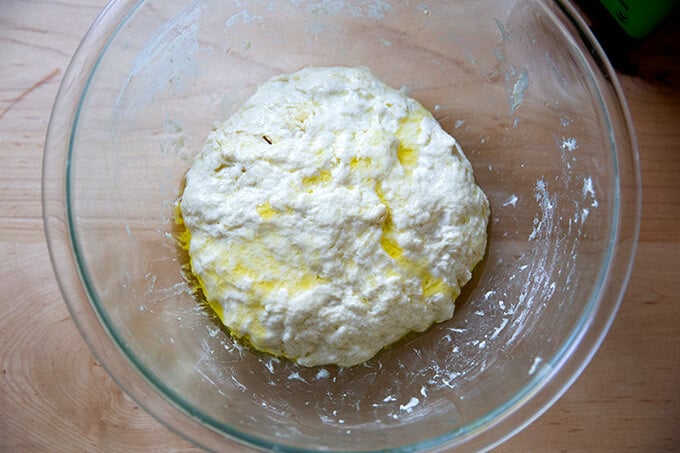
Slick the surface of the dough with olive oil; then cover the bowl. You all have one of these, right? Stick the bowl in the fridge immediately; leave it there to rise for 12 to 18 hours (or longer—I’ve left it there for as long as three days). NOTE: It is important the dough really be slicked with olive oil especially if you are using a cloth bowl cover or tea towel as opposed to plastic wrap or the lid pictured in the photo below this one. If you are using a tea towel, consider securing it with a rubber band to make a more airtight cover. If you do not slick the dough with enough oil, you risk the dough drying out and forming a crust over the top layer.
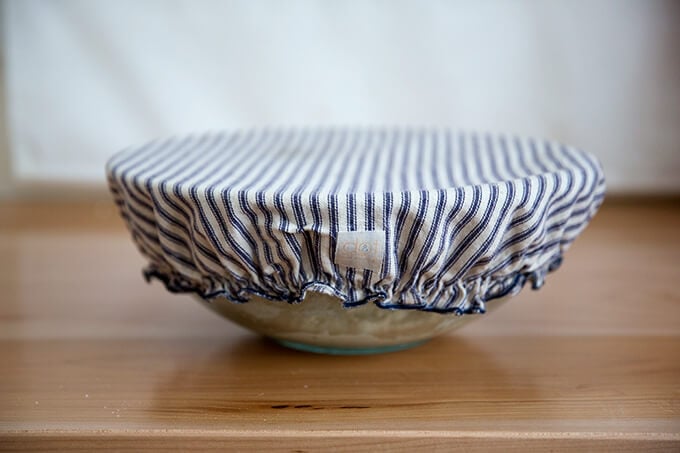
Another option: the lid that comes with the 4-Qt Pyrex bowl. This is handy for fridge storage because you can stack things on top of it.

Remove from fridge, and remove the cover:
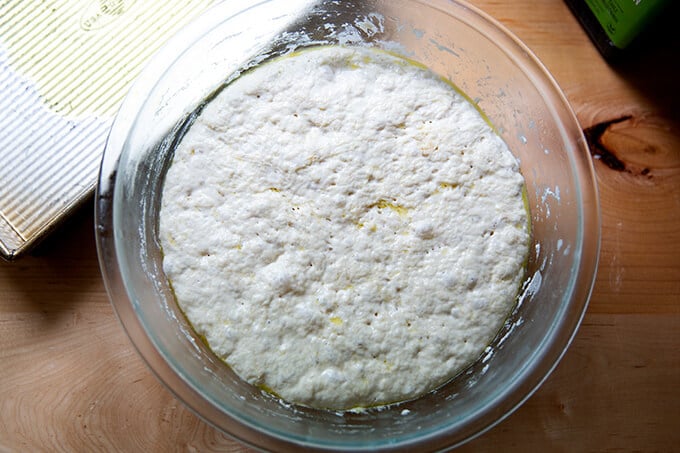
Deflate the dough and transfer to a prepared pan. I love this 9×13-inch USA pan. If you don’t have one you can use two 8- or 9-inch pie plates or something similar. If you are using glass baking dishes be sure to grease the dishes with butter before pouring a tablespoon of olive oil into each. (The butter will ensure the bread doesn’t stick.) Don’t touch the dough again for 2 to 4 hours depending on your environment.

After two to four hours, or when the dough looks like this…:

… it’s time to dimple it! You can use simply olive oil and salt — I recommend good, flaky sea salt for this. Note, the dough in the photo below spent three days in the fridge, and the dough was super bubbly!
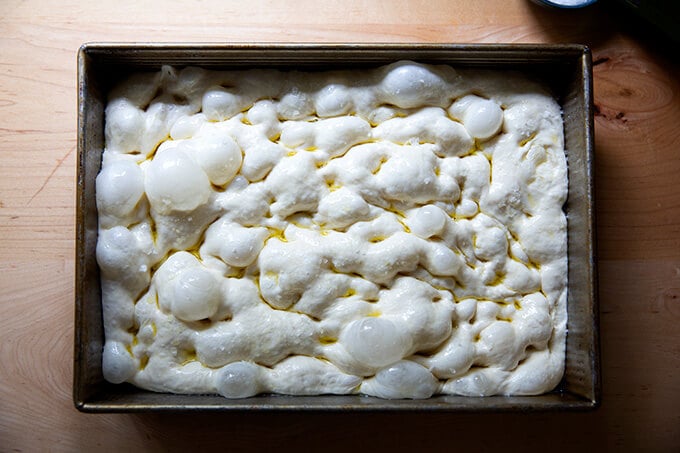
if you are using rosemary, sprinkle it over the dough. Then pour two tablespoons of olive oil over the dough, and using your fingers, press straight down to create deep dimples. Sprinkle with flaky sea salt — again, something like Maldon is great here.

Transfer to oven immediately and bake at 425ºF for 25 minutes or until golden all around. Remove focaccia from pans and place on cooling racks.
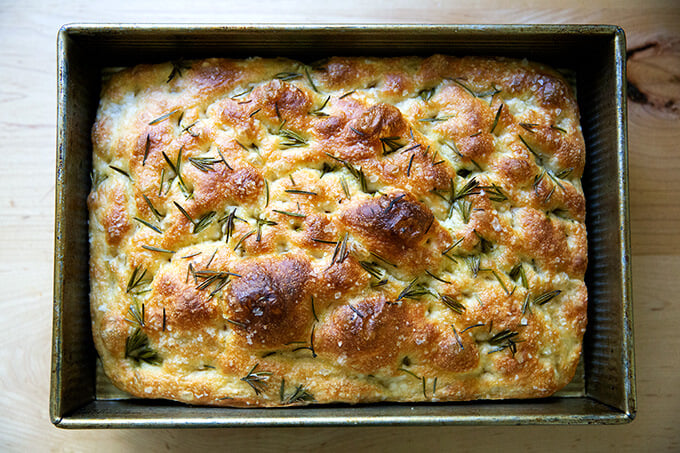

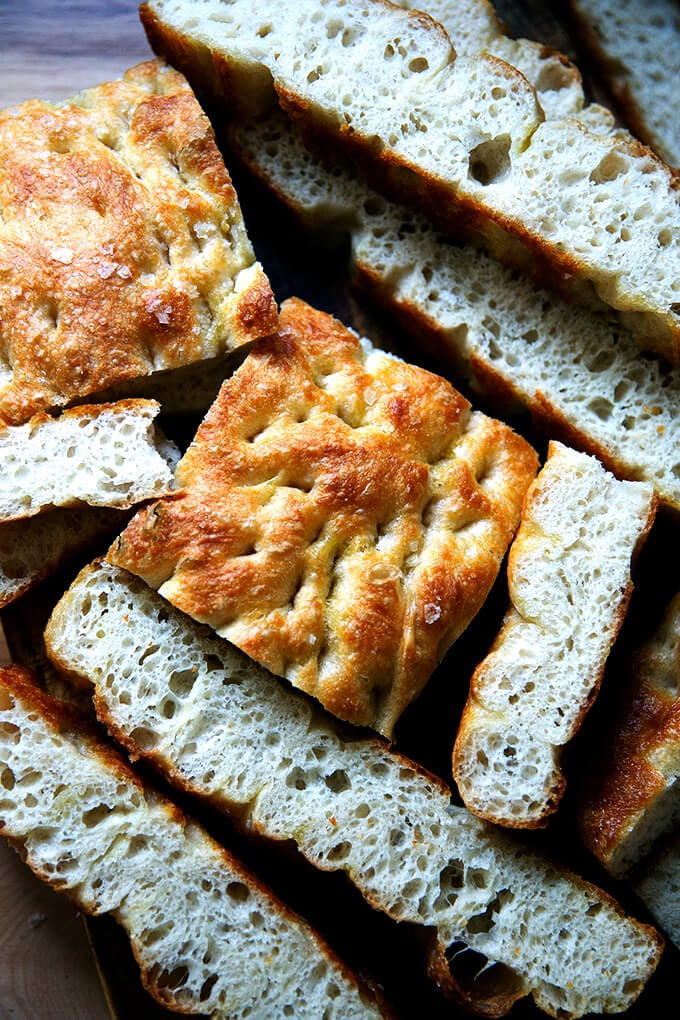
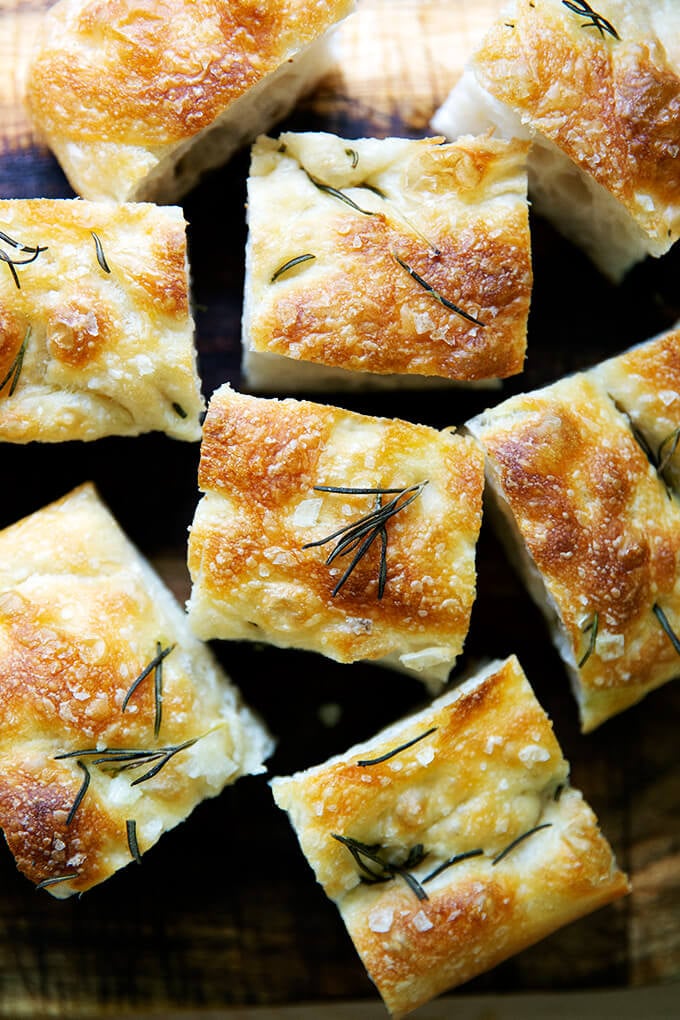
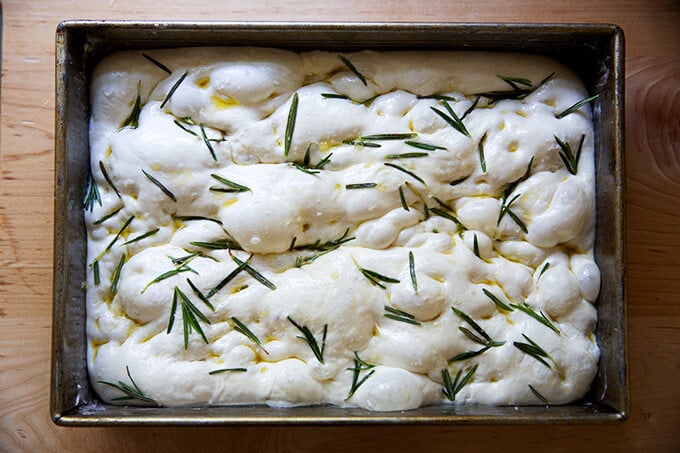
How to Incorporate Rosemary, Herbs, and Other Ingredients & Toppings into Your Focaccia Dough
One of the most frequently asked questions I get is: How can I add other toppings or ingredients to my focaccia bread? You can do this in two ways:
- Add them on top as you would rosemary or other herbs. The key is to make sure the ingredients are slicked lightly with olive oil to ensure they do not burn in the oven. I like to sprinkle the rosemary over top of the dough, then drizzle it with olive oil, then dimple the dough.
- You can add them directly to the dough. In step one, when you whisk together the flour, salt, and instant yeast, add your ingredients — chopped olives, sun-dried tomatoes, roasted garlic — to the flour and toss to coat; then add the water.

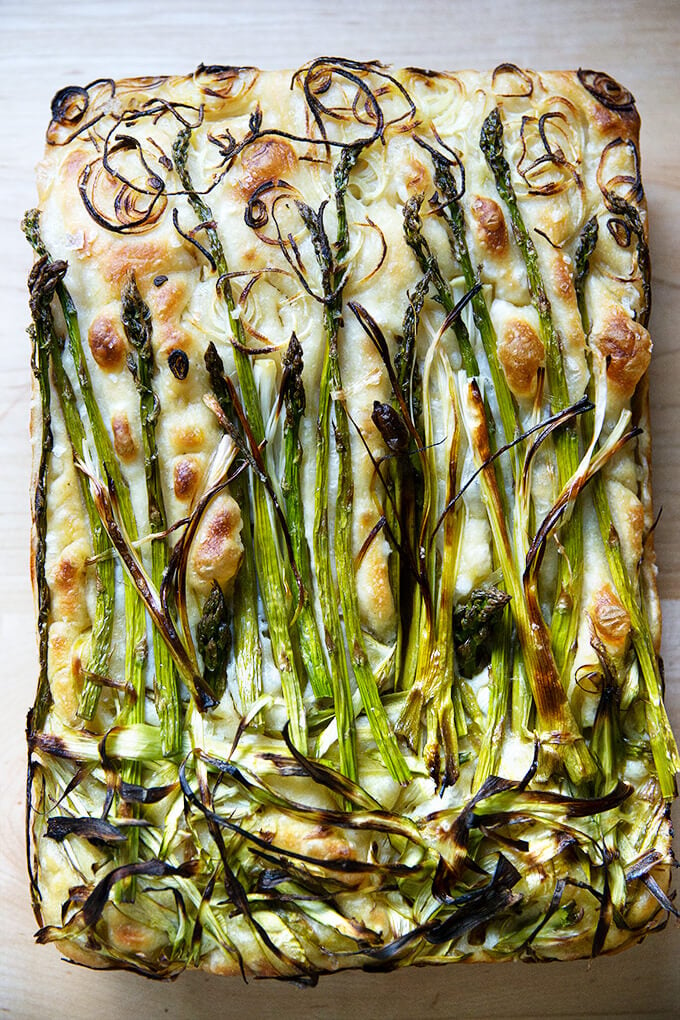
How to Make a Focaccia Bread Art
Pictured above is my “Ode to Spring” (🤣) Focaccia Bread Art (or Garden Scape). As noted above, the key with adding toppings is to slick them lightly with olive oil to ensure they don’t completely char. Keep in mind that some items will char, and a little charring is not a bad thing.
To make a focaccia bread art:
- Follow the recipe through the step in which you dimple the dough just before baking. Arrange your toppings — sliced peppers, asparagus, scallions, olives, tomatoes, onions, etc. — over top and dimple again, pressing the ingredients into the dough to embed them — you can be more aggressive than you think.
- Brush the entire surface with olive oil; then sprinkle with sea salt.
- Bake as directed.
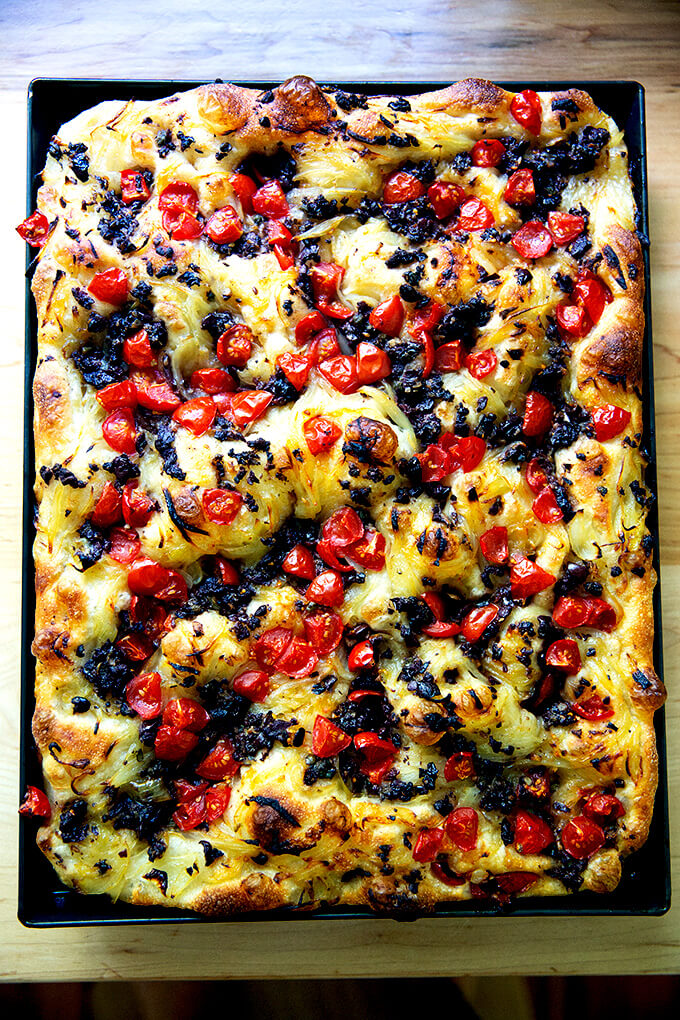
Tomato Focaccia
Pictured above is a cross between pissaladière and tomato focaccia. I love the addition of tomatoes to pissaladière because it adds a freshness and brightness, a hit of acidity to offset the sweet caramelized onions and salty anchovies, olives, and capers.
You can use any summer tomatoes you have on hand — diced cherry tomatoes, Roma, plum, sliced beefsteak tomatoes, heirloom tomatoes, etc. If you choose to dice up Roma or plum tomatoes, there is no need to seed them, but leave any juices lingering on the cutting board behind.
Top the unbaked focaccia with a thin layer of tomatoes; then bake as directed.
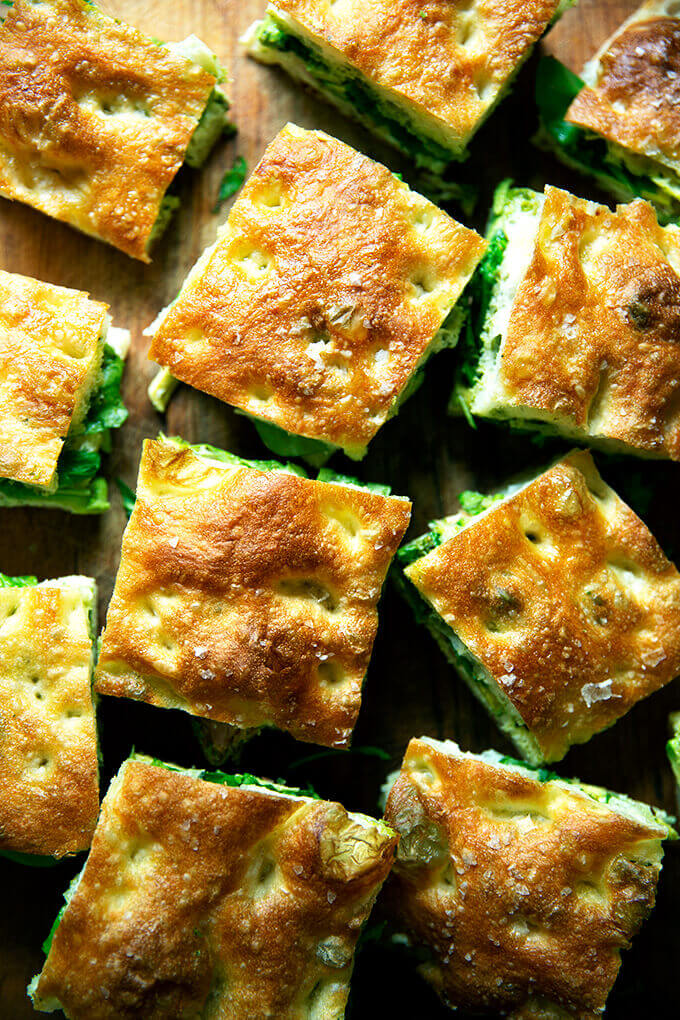
How to Make Focaccia Bread Sandwiches
One of my favorite things to do with either the rounds of focaccia or the 9×13-inch slab of focaccia is to make a giant sandwich: simply halve the whole finished loaf of focaccia in half crosswise; fill it as you wish, close the sandwich; then slice and serve.
Here’s one of my favorites: Roasted Red Peppers, Olive Tapenade, & Whipped Honey Goat Cheese
Can I Make this Overnight Focaccia Without the Overnight Rise?
Yes, you can. In fact, in my cookbook, Bread Toast Crumbs, I do not employ an overnight rise. Start-to-finish it can be made in about three hours. The finished bread will not be as pillowy, but it will still be light, airy, and delicious.
To skip the overnight rise, simply let the mixed dough rise at room temperature until doubled, about 1.5 to 2 hours. Then proceed with the recipe, knowing the second rise will only take about 30 minutes.
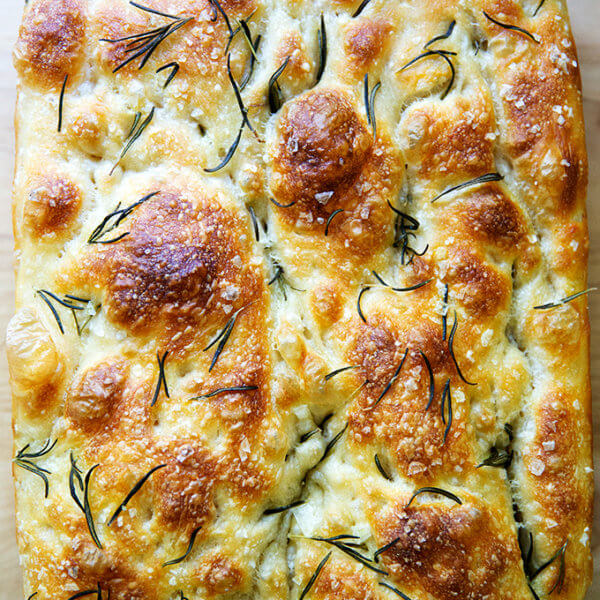
The Best, Easiest Focaccia Bread Recipe
- Total Time: 18 hours 30 minutes
- Yield: 2 loaves
Description
Cold, refrigerated dough is the secret to making delicious focaccia! Allowing the dough to rest 18 to 24 hours in the fridge will yield extra-pillowy and airy focaccia, though if you are pressed for time, you can make this start-to-finish in 3 hours. This 4-ingredient recipe requires only 5 minutes of hands-on time. Video guidance below!
Adapted from the focaccia recipe in Bread Toast Crumbs.
A few notes:
- Plan ahead: While you certainly could make this more quickly, it turns out especially well if you mix the dough the day before you plan on baking it. The second rise, too, takes 2 to 4 hours.
- If you are short on time and need to make the focaccia tonight: Let the mixed dough rise at room temperature until doubled, about 1.5 to 2 hours. Then proceed with the recipe, knowing the second rise will only take about 30 minutes.
- You can use various pans to make this focaccia such as: two 9-inch Pyrex pie plates. (Use butter + oil to prevent sticking.) One 9×13-inch pan, such as this USA pan — do not split the dough in half, if you use this option, which will create a thicker focaccia . A 13×18-inch rimmed sheet pan — this creates a thinner focaccia, which is great for slab sandwiches.
- As always, for best results, use a digital scale to measure the flour and water.
- I love SAF instant yeast. I buy it in bulk, transfer it to a quart storage container, and store it in my fridge for months. You can store it in the freezer also.
- If you are using active-dry yeast, simply sprinkle the yeast over the lukewarm water and let it stand for 15 minutes or until it gets foamy; then proceed with the recipe.
- Flour: You can use all-purpose or bread flour here with great results. If you live in a humid environment, I would suggest using bread flour. If you are in Canada or the UK, also consider using bread flour or consider holding back some of the water. Reference the video for how the texture of the bread should look; then add water back as needed.
Ingredients
- 4 cups (512 g) all-purpose flour or bread flour, see notes above
- 2 teaspoons (10 g) kosher salt
- 2 teaspoons (8 g) instant yeast, see notes above if using active dry
- 2 cups (455 g) lukewarm water, made by combining 1/2 cup boiling water with 1 1/2 cups cold water
- butter for greasing
- 4 tablespoons olive oil, divided
- flaky sea salt, such as Maldon
- 1 to 2 teaspoons whole rosemary leaves, optional
Instructions
- Make the dough: In a large bowl, whisk together the flour, salt, and instant yeast. Add the water. Using a rubber spatula, mix until the liquid is absorbed and the ingredients form a sticky dough ball. Rub the surface of the dough lightly with olive oil. Cover the bowl with a damp tea towel, cloth bowl cover, or plastic wrap and place in the refrigerator immediately for at least 12 hours or for as long as three days. (See notes above if you need to skip the overnight rise for time purposes.) NOTE: It is important the dough really be slicked with olive oil especially if you are using a cloth bowl cover or tea towel as opposed to plastic wrap or a hard lid. If you are using a tea towel, consider securing it with a rubber band to make a more airtight cover. If you do not slick the dough with enough oil, you risk the dough drying out and forming a crust over the top layer.
- Line two 8- or 9-inch pie plates or a 9×13-inch pan (see notes above) with parchment paper or grease with butter or coat with nonstick cooking spray. (Note: This greasing step may seem excessive, but with some pans, it is imperative to do so to prevent sticking. With my USA pans, I can get away with olive oil alone; with my glass baking dishes, butter is a must.)
- Pour a tablespoon of oil into the center of each pan or 2 tablespoons of oil if using the 9×13-inch pan. Using two forks, deflate the dough by releasing it from the sides of the bowl and pulling it toward the center. Rotate the bowl in quarter turns as you deflate, turning the mass into a rough ball. Use the forks to split the dough into two equal pieces (or do not split if using the 9×13-inch pan). Place one piece into one of the prepared pans. Roll the dough ball in the oil to coat it all over, forming a rough ball. Repeat with the remaining piece. Let the dough balls rest for 3 to 4 hours depending on the temperature of your kitchen (Note: no need to cover for this room temperature rise).
- Set a rack in the middle of the oven and preheat it to 425°F. If using the rosemary, sprinkle it over the dough. Pour a tablespoon of oil over each round of dough (or two tablespoons if using a 9×13-inch pan). Rub your hands lightly in the oil to coat, then, using all of your fingers, press straight down to create deep dimples. If necessary, gently stretch the dough as you dimple to allow the dough to fill the pan. Sprinkle with flaky sea salt all over.
- Transfer the pans or pan to the oven and bake for 25 to 30 minutes, until the underside is golden and crisp. Remove the pans or pan from the oven and transfer the focaccia to a cooling rack. Let it cool for 10 minutes before cutting and serving; let it cool completely if you are halving it with the intention of making a sandwich.
- Prep Time: 18 hours
- Cook Time: 30 minutes
- Category: Bread
- Method: Oven
- Cuisine: Italian
This post may contain affiliate links. Please read my disclosure policy.











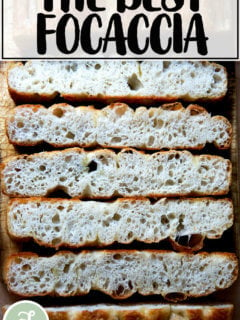


4,146 Comments on “Overnight, Refrigerator Focaccia = The Best Focaccia Bread Recipe”
This looks so delicious and I can’t wait to try it! Quick question: I have active dry yeast instead of instant – do I add the yeast to the full 2 cups of water and then mix in to the flour, or should it be just a portion of the water? I’ve never made any sort of bread before, so any advice is appreciated! Thank you!
Hi Mia! Yes, sprinkle the yeast over the 2 cups of water, let it sit for 15 minutes or so, then add it to the flour and salt. Good luck!
Thank you, so excited to try this!
Hi. I wonder if I am supposed to use the same amount of yeast if i am using active dry yeast or should i reduce amount of yeast?
Same amount is just fine!
Hi, I only have a 9 x 9inch baking pan. Would it work if I halve the recipe and bake in that pan?
Yes!
This is seriously one of if not the best focaccia recipes I’ve ever made, and I’ve made a lot! This is the only one I’ll use from now on!
Great to hear, Jocelyn! Thanks for writing 🙂
Hi your recipe is the best and use it always when making focaccia. I am wondering can I mix apf and 00 flour to make this? Thank you
Hi Mira! Yes, definitely. You may want to slightly reduce the amount of water you are using… try holding back 50 grams or so.
Any changes for baking at high altitude? Looking forward to making this, would love to know what adjustments I might need to make. Thanks!
You shouldn’t have to! I have a dear friend who makes this at high altitude all the time. I think the long, slow fridge rise in combination with the high hydration make this work well at high altitude.
LOVE THIS!! I am making it today for the 3rd time this week. Thank you so much. Delicious & super easy. At times for me it feels expensive and inconvenient to feed myself & my people healthy items. But next this has become a staple I am sure.
I next will be looking for a more sandwich like bread, something for a grill cheese. Have a super day and thank you again.
My pleasure, Linzo! Thanks so much for writing and sharing all of this 🙂 🙂 🙂
i’ve used this recipe for years. me and my family love it. it’s a beautiful focaccia. a tip i have, take the focaccia out of the baking container after baking and put it on a already hot pizza stone in the oven to get a very nice crust on bottom. tomorrow i am going to try baking this focaccia in pizza oven. wondering if you or anyone else has tried this?
Wonderful to hear, Sophia, and great tip! Thanks for sharing. I don’t have experience with a pizza oven here, so I can’t advise on that front. Good luck!
I have made this multiple times and it is seriously the best recipe and so easy. Always a crowd pleaser.
Wonderful to hear this 🙂 Thanks so much for writing 💕
Hi, can I ask why the sourdough focaccia doesn’t have a rest in the fridge? Can I put it in the fridge over night after the bulk fermentation? Many thanks Jo
Hi Jo! No particular reason. You absolutely can refrigerate it after the bulk fermentation. Just be sure the dough is in a vessel with a lid or is covered tightly with plastic wrap to ensure the dough does not dry out.
Hi, just read your recipe. I use King Arthur flour and 4 cups = 480 grams (120 gm/cup). How did you get your weight?
Hi Linda, my standard is 1 cup flour = 128 grams. If you use KAF’s weight measurements here, your dough will be soupy.
I wanted foccacia, the other day.
I had never made foccacia before. But I was reading about bread on Wikipedia, I was bored, and gosh darn it, I wanted foccacia.
So I did some googling, found this recipe, and figured I’d give it a go (a recipe that encourages you to bung it in the fridge for at least an overnight? Yes, hello, I like the timing on this!)
And let me tell you. This bread? This bread is legitimately the easiest and least fussy bread I have ever made in all the twenty-odd years I’ve been baking. It rose like a dream under a damp dishtowel in the fridge, filled out delightfully when I popped it in the pan for its 3-hour sit, and did not require even one tiny tweak to the baking time – 25 minutes gave me a perfect bread, crisp but not too hard crust on the outside, lovely soft but not mushy crumb inside. Topped with rosemary sea salt? Insert chef’s kiss emote here.
I may have eaten a good chunk of it almost right out the oven and I regret absolutely nothing. 🙂
Thank you so much for this recipe – it is definitely one I’ll be making again in future!
So nice to read all of this, Lucien 🙂 🙂 🙂 Thanks so much for writing and sharing your notes. So glad this was easy and tasty … the best combo!
If you want to wow people with your food, you need to make this focaccia. I’ve made this so many times for so many people and everyone always looooooves it! In terms of avoiding sticking, I get the best result when using the cooking spray option — just a light coating on the sides/bottom of the pan before pouring in the oil. The butter option works well too, though I find the bottom doesn’t get quite as crispy. Either way, make this!!! It’s so easy and beyond delicious, especially with rosemary 🙂 Thank you for a great recipe!
Great to read all of this, Ruth! Thanks so much for writing and sharing your notes about the cooking spray. Great tip!
Made this last night/this morning. Turned out great. Could use a touch more salt, if you’re not adding herbs, I’ll probably try 12 or 13 g next time.
Great to hear, Anna! Thanks for writing and sharing your notes/thoughts 🙂 🙂 🙂
Love this recipe. Is it okay to leave dough in the fridge for longer than 3 days? Would 5 days be okay?
You may be able to get away with it … I would consider cutting the yeast back to 1 teaspoon if you want to try for that long of a cold proof.
Aexandra, thank you so much for this amazing recipe. I have made is several times now and It turns out great every time. I made it with olives, garlic and fried onion. It is always gone after one day!
Wonderful to hear, Ming! Thanks for writing 🙂 🙂 🙂
The focaccia bread is absolutely fab so I have made it twice already! I left it for one day the first time and popped fresh rosemary on top with salt and olive oil. My husband begged me to make some more so I added sliced olives and olive oil to the top of the bread in the final stage, using less salt on top. This time I left it for two days and it was so fluffy (great when you have a meal plan for the week so can plan ahead).
It worked a treat. A great go to recipe which is soooo easy to make!
Thank you for sharing this one, Ali!
Great to hear this, Roberta! Discovering that the dough can spend many days in the fridge was such a revelation. It’s so nice to know I can mix the dough on Wednesday and be prepped for a Friday dinner with friends. Thanks so much for writing and sharing your notes 🙂 🙂 🙂
Hi! I measured the flour and water with my digital scale (and followed the 1.5 cups cold water to .5 cups of boiling water to the amount of grams mentioned in the recipe). When I added the water to the flour, I was left with a very wet dough. So wet that while it wasn’t watery or soupy, there was no way I was able to shape it into a ball. It was just too loose to do so. I put it in the fridge, covered, and am coming up on hour 13. If the water hasn’t firmed this up at all, I’m still going to bake it but is there any modification I should make after transferring it to the 9X13 pan for the 2-4 hours?
Hi Angie! It’s probably a matter of environment and flour — what type of flour are you using? And do you live in a humid environment? At this point, just push on! It will still be delicious. And it’s too late to incorporate more flour. Report back if you have time 🙂
I’m baking it later today! I used white lily’s all purpose flour and it’s not overly humid but I suppose that had to be a factor. When I placed it in my oiled dish in which I will bake it later, it spread out quite a bit (not a ball shape or firm enough to be such) but I have hope that it will still taste delicious! Thanks again!
Hi Angie! I think the flour is the issue… White Lily flour is bleached and has only a 9% protein content, which is not great for bread — it’s great for light, fluffy cakes and muffins. Fingers crossed it turned out OK for you!!
This was soooo gooood Ali, yum. There is nothing better than homemade focaccia. My favorite is to put artichoke dip on it. Okay, now i’m drooling, lol. Time to go to the store 🙂
Great to hear, Emma 🙂 🙂 🙂 Thanks so much for writing.
Love this recipe!! Super simple for someone who doesn’t make bread often/doesn’t know how at all.
Great to hear, Sara!
Half way through your recipe, it’s currently sitting in the fridge.
When I put it in the pan to rise again, do I cover it with a damp towel/ plastic wrap? Or leave it open but we’ll covered in oil?
Cheers.
No need to cover with a towel or plastic wrap — the coatin of oil will protect it from drying out. Good luck!
Thank you soo much, it is incredible. However the bottom didn’t crisp at all. Basically baked to the pan.
Any advice?
Cheers
Hi! What material pan did you use? And did you butter it first? Finally, did the dough stick to the pan? Is that what you mean by “baked to the pan”?
Hi Ali! Could you please tell us how long you recommend baking this recipe if you choose to use a 13” x 18” rimmed sheet pan for slab sandwiches? Thank you!
Hi Marion! I would imagine it would need about 20 minutes. Start checking at around 18 minutes; then bake it until it is golden to your liking. It’s a forgiving dough, so I’d err on overbaking.
Very nice focaccia! Question: since the first focaccia was made with past-prime Jim Lahey dough (which required 1/4 teaspoon of yeast) why does your recipe use 2 teaspoons? Jim Lahey’s focaccia recipe has 2.5 teaspoons of yeast, but for 800 grams combined flour and potato puree – and the fermentation is only 2-3 hours, rise of 45-60 minutes (both at room temperature). Please explain more about your experimentation with varying amounts of yeast.
Hi Ann! My dough goes into the fridge immediately after mixing, which is why it calls for more yeast. You can actually get away with using less yeast, but people have so much success with the 2 teaspoons, and it doesn’t taste too yeast at all, so I’ve left the recipe as is.
Hi, just a question – is it possible to use the dough to make rolls?
You can but the dough is very wet. Two thoughts: reduce the water slightly to make the dough easier to handle or make this recipe: Easy, No-Knead Dinner Rolls
I have made this recipe several times, and my husband loves it. He used to make the bread. Now he says mine is better than his! Thanks for the recipe. I have a question. My daughter is gluten intolerant. Can I make this into a gluten free bread?
Sincerely, Janet
Wonderful to hear this, Janet! I unfortunately have not tried simply swapping in g-r flour here, but it is worth a shot. I would definitely go with a mix, such as Cup for Cup, as opposed to simply using coconut flour or garbanzo bean flour, etc. Those mixes have ingredients in them that will lend structure to the dough. No need to do two rises with g-f bread baking: simply mix, let the dough rise, dimple (if you are able to… most g-f bread recipes are almost batter-like in texture), then bake.
Today is the third time I’m making this focaccia and I’m baking it same day without the overnight rise. It’s a lovely, lovely recipe. This time I added kalamata olives, crumbled feta, red onion and the tiniest amount of chopped rosemary plus maldon salt. I was careful with the salt because of the saltiness of my other additions and it was perfect.
I put the oil on after I topped the dough, then dimpled it. I used a 13×9 glass pan that was generously buttered, then oiled and the bread popped out easily with no sticking. Crispy outside, soft inside.. I will make this recipe over and over and over. It’s just plain delightful!
Wonderful to hear this, Kathy! Thanks so much for writing and sharing your notes. Your latest topping combination sounds lovely!!
I work in the bakery for almost twenty years. We do make many breads, but this recipe is truly awesome. Thanks!
Great to hear Dong!
Thank you thank you and thank you. I have made so many foccacias but this ends my search. ITS PERFECT! Do you recommend parbaking and freezing if i needed to make a few days in advance? I would like to make four loaves for an event
Hi Elaine! Great to hear. I actually would recommend baking fully; then freezing once completely cooled. You could cut back the baking time by 5 minutes or so, to ensure it doesn’t brown too much upon reheating.
Also: You can keep the dough in the fridge for 3 days, so that is an option, too, though it does make your event day a little more involved 🙂 Good luck!
Thank you i Will do that
I’ve tried this a few times and each time my focaccia comes out a bit more dense than I would like. Am I not using enough water? I proved it for nearly 20 hours the first time and then 4 hours on the second one so I don’t think it’s got to do with a lack of proofing time. Thanks!
Hi David! What type of flour are you using? Are you using a scale to measure? I do think a longer cold proof helps improve dough texture: try 48 hours next time (if time permits!).
Thank you for such a fun, simple-to-follow recipe! Although I added too much water to the dough (should have held some back as I’m in Canada!), it was still very tasty and soft.
I have one question: is the 3-4 hour second rise time crucial, or should you go based on how it looks? My dough was doubled in size around the 2.5 hour mark (had it in the fridge for the first rise overnight), so I figured it best to dimple it and put it in the oven, but I found it didn’t hold the dimples very well and the crumb was a bit dense. Should I have let it keep rising? I know the issue might lie in the fact that I used too much water, but I still wanted to check for the next time I bake. Can’t wait to make this again with some rosemary on top! Thanks!
Hi Rebecca! Normally I would say to rely on the visual cues, but given that your crumb was a little dense, I might suggest waiting at least 3 to 4 hours next time. Too much water definitely could be contributing as well. Are you using a scale to measure?
Can you tell me the nutrition facts on this recipe?
I loved making this bread as it was so simple. It turned out really well and was very light and airy. Normally it’s a messy bread to make but I hardly had to. It’s so tasty too😊
Great to hear, Janice! Thanks so much for writing 🙂